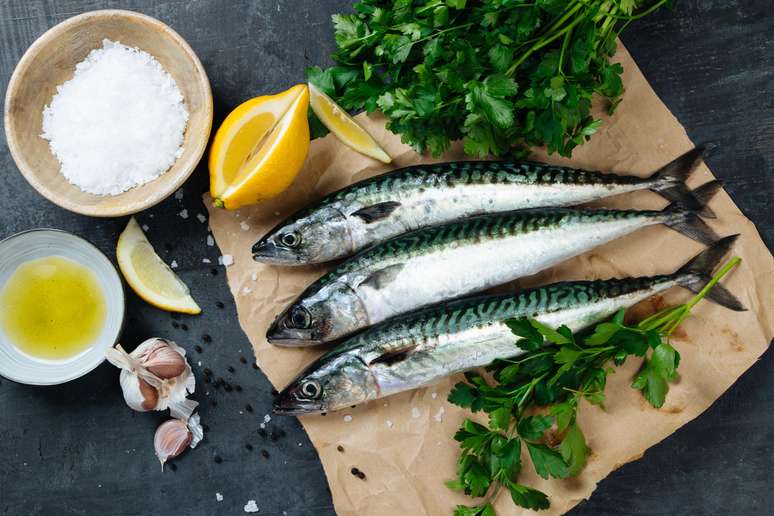For the specialists, dry aging of tuna, dorado and mackerel enhances textures and flavours
html[data-range=”xlarge”] figure image img.img-b4cc00bd0d1ee0b9adff403b2e57bc500xbqu0im { width: 774px; height: 516px; }HTML[data-range=”large”] figure image img.img-b4cc00bd0d1ee0b9adff403b2e57bc500xbqu0im { width: 548px; height: 365px; }HTML[data-range=”small”] figure image img.img-b4cc00bd0d1ee0b9adff403b2e57bc500xbqu0im, html[data-range=”medium”] figure image img.img-b4cc00bd0d1ee0b9adff403b2e57bc500xbqu0im { width: 564px; height: 376px; }
Amazing! Aging the fish refines the flavors and increases the tenderness. For Gerônimo Athuel, this is not a theory, it is daily practice. A little over a year ago, the chef started serving cured fish in his backyard. The house became such a popular restaurant that he was forced to take his boat and move three buildings along the street. But, well, that’s another story.
What matters here is that Seu Ocya, on the first of the nine islands of Barra da Tijuca, in Rio, unassumingly taught that good fish cannot be eaten when it comes out of the sea: “We store whole fish in a dry environment for a period of time such that, at the moment of service, there is a sensation of freshness, intensity, softness”.
This applies to dorado, oily fish, mullet, bonito-cachorro, faqueco, xerelete, ubarana, horse mackerel, olet and tuna: “At least they spend a week, ten days intact. But fish weighing 30 kilos have already reached 80 days, because the higher the fat level, the more they resist”.
In other words, Geronimo is rocking dry age. To do this, a complete guide follows: meticulous cleaning, evisceration and scaling of “exemplary” fish, that is, without any wound or anomaly, ethically caught and immediately placed on the ice.
Although it has nothing to do with dry-aging per se, ikejime, a Japanese fishing method that causes immediate brain death and drains the animal’s blood, preserving the texture and flavor of its meat, is a small push towards dry maturation. “Sustainably fished, with no adrenaline radiating through the meat, it will naturally taste better,” believes the cook, who, yes, is also a fisherman.
Once the preys arrive in the kitchen, they are hung on hooks, well separated from each other, and subjected to a refrigeration system with controlled humidity and a temperature that oscillates between -1°C and 3°C.
Packaged without salt, preservatives or anything else, the different species get rid of many impurities – those that are usually blamed for the “fishy” taste and smell. So much so that, if on the outside its showcase displays fish with shiny eyes and skin, no smell is exhaled inside.
“We grew up listening to buy the freshest fish possible and serve it even faster. With dry-aging you gain another perspective”, bets the enthusiast. Indeed, the conclusion has been drawn by the Japanese for centuries.
In Japan, great sushi chefs have always marinated, smoked or wrapped their catch in seaweed. Both to last longer and to deepen the sensations of the sushi they would serve. During this rest period away from water and heat, the muscles break down and the fat becomes more pronounced, resulting in a product that is more tender, greasier and concentrated in umami (in layman’s terms, the essence of goodness).
“A ubarana, so soft you can scrape it off with a spoon, adheres better to sauces and dressings than when fresh. It melts in the mouth,” explains Gerônimo. In other words, the cook argues that dry-aged fish is cleaner, more ethical and, ultimately, tastier.
If the resource is so miraculous, why not dry the fish? “For this technique to work, you need a fish caught in the day, which arrives practically alive, otherwise it starts to stick”, she warns.
However, there are no rules for using it: “You are in daily contact with each fish and this generates intimacy and reflection. When it is ready, it is as if it warns you. Then you start removing each piece with respect and of course not. You will not despise anything, because he’s almost part of your family.”
The visceral relationship of the fisherman-cook translates into sashimi of white fish with tiger milk and crispy flakes (R$ 59), thick and crunchy slices with citric parsley aioli (R$ 76) and grilled boneless fish that with rice lemon, farofa and french fries (R$192 for 2 people).
It also occasionally appears on off-menu items, such as tostaditas with the eye, smoked mortadella nestled in the stomach of fish and fins with spicy caramel, for example.
To verify the holistic treatment reserved for fish at Ocya, booking is recommended. Otherwise, after making the short boat crossing (access is via Barra Point Shopping and Jardim Oceânico metro station, R$6), the queue could exceed two hours.
Service
Ilha Primeira, Barra da Tijuca, Rio de Janeiro. Wed and Thu, 12:00 to 18:00. From sex. to Sun., from 12h to 22h. Phone: (21) 97286-1250
Source: Terra
Ben Stock is a lifestyle journalist and author at Gossipify. He writes about topics such as health, wellness, travel, food and home decor. He provides practical advice and inspiration to improve well-being, keeps readers up to date with latest lifestyle news and trends, known for his engaging writing style, in-depth analysis and unique perspectives.







